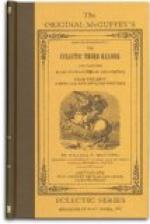13. A Diaeresis is put over the latter of two vowels, to show that they belong to two distinct syllables; thus, cooperate.
14. A Section is used to divide a discourse or chapter into parts.
15. An Index points out something that requires particular attention.
16. A Paragraph denotes a new subject. It is used in the common version of the Bible.
17. Certain marks and sometimes figures and letters are used to refer to some remark in the margin.
18. A Caret (^) is used in writing, to show that some-thing is omitted; as, Manner. I love her for her modesty and virtue.
ARTICULATION. (9)
ELEMENTARY SOUNDS
Articulation is the utterance of the elementary sounds of a language, and of their combinations.
An Elementary Sound is a simple, distinct sound made by the organs of speech.
The Elementary Sounds of the English language are divided into Vocals, Subvocals, and Aspirates.
Vocals are those sounds which consist of pure tone only. They are the most prominent elements of speech. A diphthong is a union of two vocals, commencing with one and ending with the other.
Subvocals are those sounds in which the vocalized breath is more or less obstructed.
Aspirates consist of breath only, modified by the vocal organs.
VOCALS.
Directions for articulation.
1. Let the mouth be open, and the teeth, tongue, and palate in their proper position.
2. Pronounce the word in the chart forcibly, and with the falling inflection, several times in succession; then drop the subvocal or aspirate sounds which precede or follow the vocal, and repeat the vocals alone.
TABLE.
Long Vocals.
Sound Word Sound Word a hate e err a hare i pine a far o no a pass u tube a fall u burn e eve oo cool
Short Vocals.
Sound Word Sound Word
a mat o not e met u us i it oo book
Remark.—In this table, the short sounds, except u, are nearly or quite the same, in quality, as certain of the long sounds. The difference consists chiefly in quantity. As a rule, the long vocals should be prolonged with a full, clear utterance; but the short vocals should be uttered sharply and almost explosively.
Diphthongs.
oi, oy, as in coin, boy. ou, ow, as in noun, now.
SUBVOCALS AND ASPIRATES.
Directions for articulation.
Pronounce distinctly and forcibly, several times in succession, words in which these sounds occur as elements; then drop the other sounds, and repeat the subvocals and aspirates alone. Each subvocal in the first table should be practiced in connection with its cognate sound.




